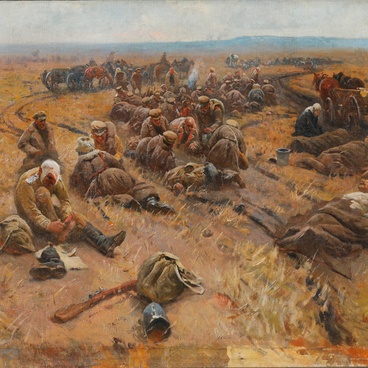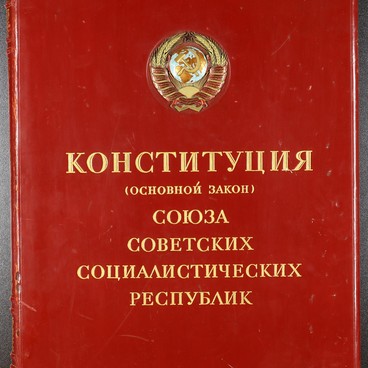The exposition presents an edition of the last USSR’s Constitution. Its development started back in 1962, but officially the new version of the country’s fundamental law was approved at an extraordinary session of the Supreme Council (Soviet) of the USSR on October, 7, 1977.
The updated Constitution stated creation of socialist society and state of the whole people. It committed the ‘leading and directing’ role of the Communist Party and new forms of ‘direct democracy’, i.e. country-wide discussion and referendum, as well as civil rights. Henceforth, Soviet citizens had the right to appeal against actions of officials, to judicial protection from offence to human honour and dignity, and to criticism of state and public organizations.
For the first time in the USSR, human rights were fixated, i.e. right to health protection, housing, use of cultural achievements, artistic freedom.
One of the main ideas of the new Constitution was the notion of ‘developed socialism’. It was determined as a ligitimate stage on the way to communism of the state, where a ‘new historical community’ had been created, i.e. the ‘Soviet people’. As the ultimate goal of the Soviet state, the fundamental law proclaimed creation of a classless communist society.
The last sections of the Constitution were devoted to the organization of legal proceedings, arbitration, advocacy, prosecutor’s supervision, as well as issues of state attributes.
The political foundation of the USSR was made up by the Soviets of people’s deputies, and as the foundation of the economic system, the Constitution proclaimed socialist ownership of the means of production. But, already in late 1980-ies, during perestroika, the Constitution was considerably changed and amended. The changes were aimed at redistributing power from party structures to state and elected bodies, at the actual separation of legislative and executive powers, and at holding elections on an alternative basis.
Based on the Union’s Constitution of 1977, an updated Constitution of the Russian Soviet Federated Socialistic Republic (RSFSR) was developed and approved of at an extraordinary session of the RSFSR on 12 April 1978.
The updated Constitution stated creation of socialist society and state of the whole people. It committed the ‘leading and directing’ role of the Communist Party and new forms of ‘direct democracy’, i.e. country-wide discussion and referendum, as well as civil rights. Henceforth, Soviet citizens had the right to appeal against actions of officials, to judicial protection from offence to human honour and dignity, and to criticism of state and public organizations.
For the first time in the USSR, human rights were fixated, i.e. right to health protection, housing, use of cultural achievements, artistic freedom.
One of the main ideas of the new Constitution was the notion of ‘developed socialism’. It was determined as a ligitimate stage on the way to communism of the state, where a ‘new historical community’ had been created, i.e. the ‘Soviet people’. As the ultimate goal of the Soviet state, the fundamental law proclaimed creation of a classless communist society.
The last sections of the Constitution were devoted to the organization of legal proceedings, arbitration, advocacy, prosecutor’s supervision, as well as issues of state attributes.
The political foundation of the USSR was made up by the Soviets of people’s deputies, and as the foundation of the economic system, the Constitution proclaimed socialist ownership of the means of production. But, already in late 1980-ies, during perestroika, the Constitution was considerably changed and amended. The changes were aimed at redistributing power from party structures to state and elected bodies, at the actual separation of legislative and executive powers, and at holding elections on an alternative basis.
Based on the Union’s Constitution of 1977, an updated Constitution of the Russian Soviet Federated Socialistic Republic (RSFSR) was developed and approved of at an extraordinary session of the RSFSR on 12 April 1978.

